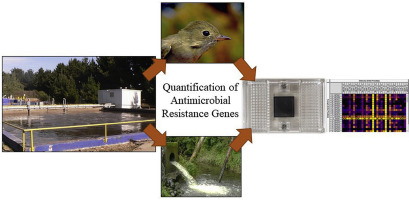International Journal of Hygiene and Environmental Health ( IF 4.5 ) Pub Date : 2019-11-10 , DOI: 10.1016/j.ijheh.2019.10.006 Irene Bueno , Claudio Verdugo , Omar Jimenez-Lopez , Pedro Pablo Alvarez , Gerardo Gonzalez-Rocha , Celia A. Lima , Dominic A. Travis , Britta Wass , Qian Zhang , Satoshi Ishii , Randall S. Singer

|
Background
Point sources such as wastewater treatment plants (WWTPs) commonly discharge their effluent into rivers. Their waste may include antibiotic residues, disinfectants, antibiotic resistant bacteria (ARB), and Antimicrobial Resistance Genes (ARG). There is evidence that ARG can be found in the natural environment, but attribution to specific point sources is lacking.
Objectives
The goal of this study was to assess the release and dissemination of ARG from three WWTPs in southern Chile via two pathways: through the river systems, and through wild birds.
Methods
A longitudinal study was conducted, collecting river sediment samples at different distances both upstream and downstream from each WWTP. Wild birds were sampled from around one of the WWTPs once a month for 13 months. A microfluidic q-PCR approach was used to quantify 48 genes covering different molecular mechanisms of resistance, and data was analyzed using ordination methods and linear mixed regression models.
Results
There was a statistically significant increase downstream from the WWTPs (p < 0.05) for 17 ARG, but the downstream dissemination through the rivers was not clear. Beta-lactamase genes blaKPC, blaTEM, and blaSHV were the most abundant in birds, with higher abundance of blaSHV in migratory species compared to resident species (p < 0.05). The gene profile was more similar between the migratory and resident bird groups compared to the WWTP gene profile.
Conclusions
While results from this study indicate an influence of WWTPs on ARG abundance in the rivers, the biological significance of this increase and the extent of the WWTPs influence are unclear. In addition, wild birds were found to play a role in disseminating ARG, although association to the specific WWTP could not be ascertained.
中文翻译:

废水处理厂对智利河流域抗菌素抗性基因环境丰度的作用
背景
诸如废水处理厂(WWTP)的点源通常将其废水排放到河流中。他们的废物可能包括抗生素残留,消毒剂,抗生素抗性细菌(ARB)和抗微生物基因(ARG)。有证据表明,ARG可以在自然环境中找到,但缺乏归因于特定点源。
目标
这项研究的目的是通过两种途径评估智利南部三个污水处理厂中ARG的释放和传播:通过河流系统和通过野生鸟类。
方法
进行了纵向研究,收集了每个污水处理厂上游和下游不同距离的河流沉积物样本。每月从其中一个污水处理厂采样一次,历时13个月。微流控q-PCR方法用于量化涵盖不同抗药性分子机制的48个基因,并使用排序方法和线性混合回归模型分析数据。
结果
17 ARG的污水处理厂下游有统计学上的显着增加(p <0.05),但通过河流的下游传播尚不清楚。β-内酰胺酶基因bla KPC,bla TEM和bla SHV在鸟类中最丰富,与常驻物种相比,迁徙物种中bla SHV的丰度更高(p <0.05)。与WWTP基因图谱相比,候鸟和常驻鸟类群体之间的基因图谱更加相似。
结论
虽然这项研究的结果表明了污水处理厂对河流中ARG丰度的影响,但这种增加的生物学意义和污水处理厂影响的程度尚不清楚。此外,尽管无法确定与特定污水处理厂的联系,但发现野生鸟类在传播ARG中起作用。











































 京公网安备 11010802027423号
京公网安备 11010802027423号